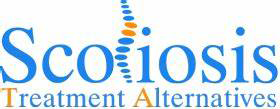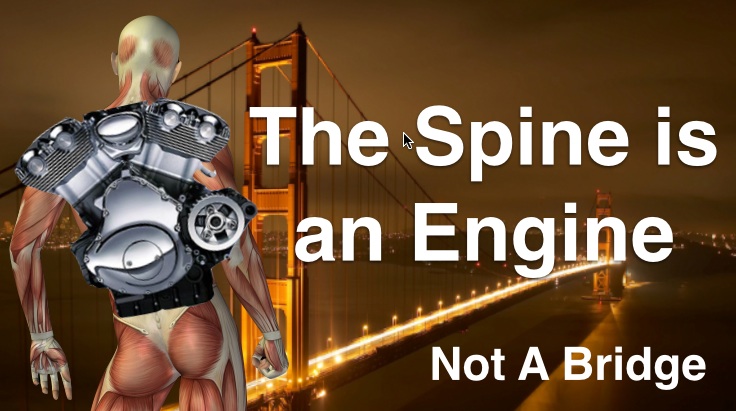“The spine is an engine, not a bridge.”
The first time I heard this statement I was somewhat perplexed and it wasn’t until the author Thomas Myers explained what he meant that I understood the enormity of the statement and how it related to scoliosis in the spine.
While most people tend to think of the spine and a bridge between the skull and the pelvis that houses and protects the spinal cord, much the same way a suspension bridge works. Myers saw that the spine has a much more dynamic function. He related that the spine is the originator of all movement in the human body and it is what drives most of our every day movements such as walking, running, reaching, climbing, etc. That’s why the spine is considered the engine that drives the movement of the body.
In fact, people that are born without arms or legs can still learn to walk because they use their spine and trunk muscles to generate the movement, just like the rest of us. (see the YouTube video below for an example)
I immediately thought of the implications for scoliosis in the spine and the importance of exploring all non-surigcal scoliosis treatment options before ever considering surgery to fuse of the spine. The point of non-surgical treatment is to use movement of the body to help correct or stabilize the curves through restoring more normal movement in a spine with scoliosis.
Surgery for Scoliosis in the Spine Fuses the Engine That Drives the Body’s Movement
While surgical intervention to correct a scoliosis in the spine provides more stability, it does it at the expense of movement. Fusing the vertebra together like an erector set that immobilizes the bones that are out of place in the spine for good.
That’s not a problem if you see the spine as merely a structural “bridge” between the skull and the pelvis and it would appear that the conventional orthopedic model of scoliosis seems to view the spine this way. How else could you explain a treatment method like scoliosis surgery that reinforces a spine with titanium rods and concrete made from ground up bone to make it more stable. If you really boil it down the concept for surgery for scoliosis in the spine is essentially to try and stabilizes the bones of the back like they are part of a bridge that needs reinforcement with steel and concrete.
The Spine is the Engine That Drives the Movement of the Body
The problem with this theoretical models is that the spine is not merely an inanimate bridge, it’s an engine that drives locomotion of the body and to fuse it will result in alterations of the biomechanics of the rest of the body. So when you consider fusing an engine it simply doesn’t make sense since fusing an engine essentially stops it for good. While scoliosis in the spine does mean your engine is not working properly the more logical solution is to tune the engine, rather than fuse it’s moving parts together.
The idea of the spine being the engine of the body was first put forward by Serge Gracovetsky, a PhD who had a back problem and went to 7 orthopedic surgeons and got 7 different answers as to what was the cause of his pain. Three of them recommended surgery 4 did not. Given that he had an inconclusive diagnosis and treatment plan he decided to study the problem himself. Having spent a lifetime systematically studying problems he was able to research the literature in a way that most of us could never do. By approaching the problem from a unique prospective came up with a revolutionary idea as to how the body works.
To illustrate my point even further let’s exam how someone without legs can walk. We tend to think that we use our legs to walk but the reality is that walking and most other movements of the body is initiated by the spine and torso. This is why we call it “the engine of the body”, because it is where the movement of the body starts.
To illustrate this point take a look at the following inspirational video about a man named Nick Vujicic who was born without arms or legs. Clearly, despite having no legs, he is able to walk the stage using only his torso for locomotion.
While this man should be an inspiration to us all, the fact that he is able to walk at all without arms or legs drives home point that it is the spine and torso that is the engine of our body and fusing it should only be considered when all else has been tried and failed.
Corrective Movement Therapy for Scoliosis in the Spine
Corrective movement therapy for the spine is a concept born from a dynamic rehabilitative model of treatment, not a static bone-out-of-place approach. It recognizes that the spine is a dynamic engine that is responsible for movement of the body. While the factors that can cause the onset of a scoliosis vary greatly, the adaptive processes that cause progression of a scoliosis is common to all.
This shared component is a maladaptive movement patterns caused by scoliosis in the spine that results in constant forces that rotate the vertebra and trunk much like a corkscrew which then results in a progressive collapse of the scoliosis curvatures onto itself due to the relentless forces of gravity pulling the spine over even more. This then causes an increase in lack of structural integrity of the spine that may cause pain which can cause further maladaptation. This is known as the Vicious Cycle of Scoliosis.
The muscles on the inside of the curve shorten and weaken while the muscles on the outside of the scoliosis curve are progressively under strain. This is what gives idiopathic scoliosis the characteristic look of having the muscles on the outside of the curve bulging out due to the strain while the muscles on the inside of the curve are shortened and weakened. Therapeutic interventions for this type of disturbance in the movement patterns of the body need to address the specifically weakened areas of scoliosis in the spine.
Scoliosis Exercises
Treatment such as the Schroth Method of scoliosis exercises are designed to help lengthen and strengthen the specific weakened muscles on the inside of the scoliosis curves to help reduce the strain to the overworked muscles on the outside of the curve.
Scoliosis Brace
Other types of corrective movement therapies include the use of a dynamic scoliosis orthosis called SpineCor. While SpineCor is classified as a scoliosis brace, it really shouldn’t be considered a brace at all. In fact, it’s often called the “Un” brace for scoliosis. SpineCor is an elastic that moves with the body so you can move any direction, but while it’s worn it gives the body a constant reminder to move into the direction of correction so that your body is able to develop new patterns of movement that are corrective.
Both the SpineCor brace and the Schroth Method of scoliosis exercises are used in our offices to treat scoliosis. In fact, research has shown that combination therapy using bracing (like SpineCor) and scoliosis exercises (like Schroth) has the best outcomes of all conservative managements.


I would like information about where I can be treated using the nu schroth exercises and would like to explore the spine core brace. I am 76 years of age and my scoliosis is processing very rapidly of late and I am in a great deal of pain which is changing my lifestyle rapidly as well. I live in Northern Virginia.
Dorothy,
Please give us a call at (800) 943-1254 for a Free Phone Consult to find out if our treatments are right for you and to see which of our offices would be best for you.
What is the reply to Dorothy Friedlander…..just to call?
About half of the patients we help each year are adults with scoliosis, many of them are seniors, so chances are we could help Dorothy too, but since each case of scoliosis is different we always want to discuss each case individually to find out if our treatments are right for them.